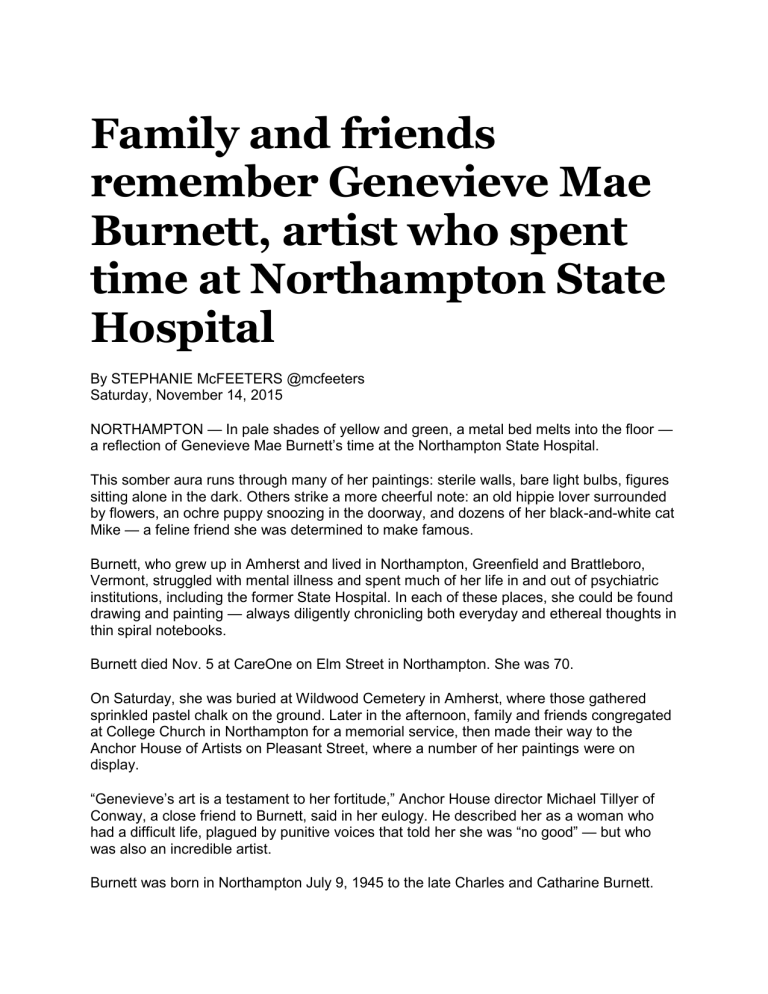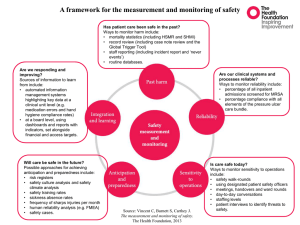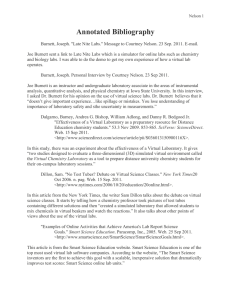Family and friends remember G Burnett

Family and friends remember Genevieve Mae
Burnett, artist who spent time at Northampton State
Hospital
By STEPHANIE McFEETERS @mcfeeters
Saturday, November 14, 2015
NORTHAMPTON — In pale shades of yellow and green, a metal bed melts into the floor — a reflection of Genevieve Mae Burnett’s time at the Northampton State Hospital.
This somber aura runs through many of her paintings: sterile walls, bare light bulbs, figures sitting alone in the dark. Others strike a more cheerful note: an old hippie lover surrounded by flowers, an ochre puppy snoozing in the doorway, and dozens of her black-and-white cat
Mike — a feline friend she was determined to make famous.
Burnett, who grew up in Amherst and lived in Northampton, Greenfield and Brattleboro,
Vermont, struggled with mental illness and spent much of her life in and out of psychiatric institutions, including the former State Hospital. In each of these places, she could be found drawing and painting
— always diligently chronicling both everyday and ethereal thoughts in thin spiral notebooks.
Burnett died Nov. 5 at CareOne on Elm Street in Northampton. She was 70.
On Saturday, she was buried at Wildwood Cemetery in Amherst, where those gathered sprinkled pastel chalk on the ground. Later in the afternoon, family and friends congregated at College Church in Northampton for a memorial service, then made their way to the
Anchor House of Artists on Pleasant Street, where a number of her paintings were on display.
“Genevieve’s art is a testament to her fortitude,” Anchor House director Michael Tillyer of
Conway, a close friend to Burnett, said in her eulogy. He described her as a woman who had a difficult life, plagued by punitive voices that told her she was “no good” — but who was also an incredible artist.
Burnett was born in Northampton July 9, 1945 to the late Charles and Catharine Burnett.
From a young age, Burnett was traumatized by going to school, said her brother Robert
Burnett, 68, of Southampton. She began seeing a child psychologist when she was about 6, and was diagnosed with paranoid schizophrenia as a teenager.
But her artistic inclination, he said, ran just as deep. Even by kindergarten she had distinguished herself: “no stick figures and distorted houses and sunshines that most kids have,” he said. His mother, a nature-lover, encouraged his sister’s painting. The Burnett
Gallery at Amherst’s Jones Library is named for their grandfather, an art collector.
Robert Burnett was his sister
’s good-time Charlie, he said, explaining how at restaurants he would drop pickles into a glass of water or play a french-fry puppeteer to make her laugh.
Genevieve Burnett mumbled, had a flat affect and was somewhat deaf, due to years of harming herself to stop the voices she heard, and many were unsure if she could live on her own, said Gillian Cook, 60, of Leverett, who was Burnett’s case manager about 30 years ago. But independence was something Burnett truly wanted, Cook said, noting that she had
“reserves of determination and strength that weren’t obvious.” So, Cook helped Burnett find her own apartment and get her driver’s license.
“She was an artist, that was her identity,” Cook said. That’s what grounded her.”
Burnett was one of the first people to frequent the Anchor House, a studio and gallery that helps artists with mental illness, Tillyer said, recalling how she showed up one day with an oil painting still dripping wet. Her preference was to sit on the floor, painting on a small easel she traveled with for that purpose, he said.
She identified strongly with Dutch painter Vincent Van Gogh, whose history with mental illness is well known. In one of her paintings, an angelic figure emerges from waves overlaid with the name “Vincent” and other text. Tillyer said he thinks it’s a self-portrait, depicting
Burnett rising from Van Gogh’s spirit.
As an artist, Burnett was always trying to arrange exhibitions for herself, at one time packing up her station wagon and setting off to a gallery in Colorado, Tillyer said. Over the years, he helped her sell some of her work in Boston and New York, and is currently trying to arrange her autobiography. Around 700 of her paintings remain at Anchor House, Tillyer said, where he has worked with Hampshire College interns to catalog them. One intern, Hampshire senior Jo O’Lone-Hahn, 21, of Kemblesville, Pennsylvania, has spent the past three years reading and organizing Burnett’s journals and assorted writings, which date to 1959.
These journals, O’Lone-Hahn said, portray a woman with a life as “chaotic as anyone’s.”
Burnett recorded her struggles, friendships and daily tasks
— her writing slowly disintegrating over time. In her musings about art, Burnett referenced having synesthesia, a phenomenon where different senses are associated with one another, and described different “color essences,” O’Lone-Hahn said.
Burnett’s writings span from simple lists to poetry, much of it haunting.
“Then again I can see a lot of things. But what I see is not necessary ‘Real,’’ she wrote in one undated entry. “Only the shadows reflected in my mind, I can’t see the molecules.”
Northampton resident Rebecca Macauley, 61, first came to know Burnett at the
Northampton State Hospital, where the two were “locked up together” in the 1980s, she said . That experience was a “combination of devastation, loneliness, fear, dread — really feeling like you don’t belong in the world,” Macauley said. “And she captures it perfectly in her art.”
Indeed, gesturing to Burnett’s work, Macauley said she recognized the barred windows and peeling pink paint of a space known as the seclusion room — “the NSH zeitgeist” seared into her memory.
“She turned her demons in to art,” Macauley said.
In addition to her brother Robert, Burnett is survived by his wife Tawnya of Southampton, her brother Tad Burnett and his partner Marie Frazier of Mt. Holly, Vermont and her former sister-in-law Marilyn Schupp, along with several cousins, nieces and nephews.
Stephanie McFeeters can be reached at smcfeeters@gazettenet.com.







